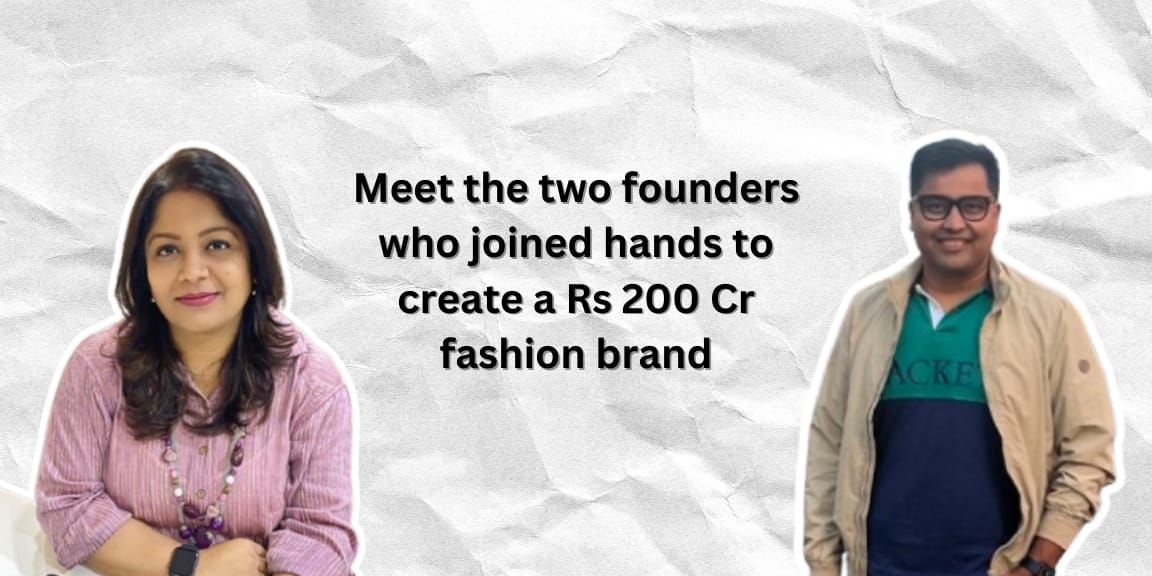In 2014, two professionals from vastly different worlds took a leap of faith and entered the competitive world of fashion. Ragini Roy, with her deep understanding of customer preferences and fashion, and Shrikant Chandak, a numbers-driven entrepreneur, came together with a shared vision: to create a brand that would redefine ethnic fashion for modern Indian women. This vision gave birth to Varanga, a brand that is today a household name in women’s clothing and generates an annual revenue of Rs 200 crore.
What makes their journey truly remarkable is the fact that they started with an initial investment of Rs 20 lakh, bootstrapping their way into an industry filled with well-established players.
Varanga now caters to millions of women across India, offering an elegant fusion of traditional and contemporary designs through categories like kurtas, kurta sets, coords, dresses, and bottom wear. The brand has not only captured the hearts of Indian consumers but has also expanded its reach to four countries, serving over 15 million customers worldwide.
Taking a leap of faith
When Roy and Chandak first met, fashion was not an obvious choice for either of them. Roy, with her creative flair and customer-focused mindset, brought a wealth of knowledge about consumer behaviour and trends. On the other hand, Chandak had a strong financial background, with expertise in business strategy and scaling operations. Together, they represented a unique blend of complementary strengths.
“Fashion was an unconventional path for us,” Roy says. “But we were drawn to the challenge. We saw a gap in the market for stylish, ethnic wear that resonated with self-reliant, fashion-forward women, particularly those in the 25 to 45 age group.”
The duo invested Rs 20 lakh from their personal savings into Varanga. Their goal was clear: to create a brand that offered quality, versatile ethnic clothing that could be worn casually and on special occasions.
Crafting a unique brand identity in a crowded market
The Indian ethnic wear segment is notoriously competitive, dominated by legacy brands with deep pockets and decades of customer loyalty. For Varanga, breaking through this noise meant focusing on differentiation. The founders knew that creating a distinctive brand identity was crucial.
“One of our biggest hurdles was standing out in a market saturated with established players,” Chandak says. “We had to find our niche, which led us to focus on blending traditional elements with contemporary designs. This fusion allowed us to cater to the modern working woman who wanted the best of both worlds—style and tradition.”
This unique positioning helped Varanga resonate with its target audience. From kurtas and kurta sets to coords and dresses, each piece reflected a balance of heritage and modernity, appealing to women who were as comfortable in boardrooms as they were at social gatherings.
Varanga’s design philosophy quickly caught on, but building brand trust was no easy feat.
Building trust in the digital age
To overcome the initial visibility hurdle, Roy and Chandak leaned heavily on digital marketing and social media. They understood that the emerging ecommerce market was fertile ground for reaching their audience directly. They invested time and resources into understanding customers’ needs and preferences, which allowed them to create collections that spoke to them personally.
This approach paid off. Varanga’s presence on leading Indian online marketplaces like Myntra, Amazon and Flipkart allowed it to gain momentum quickly. Positive reviews began to pour in, and the brand soon built a loyal customer base that appreciated its commitment to quality and the unique blend of ethnic and contemporary styles.
As the brand grew, it expanded its product offerings while maintaining the ethos that had made it successful. The founders introduced new designs and product categories, including bottom wear, to cater to the evolving needs of their customers.
Scaling while staying true to the brand ethos
Scaling the business, however, came with its own set of challenges. The duo was keenly aware that rapid growth could jeopardise the quality and consistency that their customers had come to expect. To mitigate this risk, they streamlined operations and enhanced their supply chain.
Today, Varanga employs 150 people, 80 of whom are women, a testament to the brand’s commitment to empowering women—not just through its clothing but also through its workforce.
“Empowering women has always been at the heart of Varanga’s mission,” Roy says. “We design for women who are independent and confident, and our team embodies that same spirit.”
What does the future hold?
As Varanga continues to grow, the brand is actively exploring investment opportunities to scale operations even further. It is seeking strategic partners who can help the brand expand into new markets, enhance its digital presence, and diversify its product line.
Since its inception in 2014 with a modest collection of 100 products, Varanga has come a long way. Today, it serves millions of customers across four countries, staying true to its core values of quality, style, and women empowerment. What started as an unlikely partnership between two visionaries has blossomed into a Rs 200-crore brand—a testament to the power of passion, perseverance, and the willingness to embrace risk.
The story of Varanga is not just about fashion; it’s about creating something meaningful in an ever-evolving industry. To the founders, Varanga is more than just a business—it’s a legacy of style, strength, and empowerment for the modern Indian woman.







![Read more about the article [Funding roundup] Open joins unicorn club; BarRaiser, Twixor, Frendy and others raise capital](https://blog.digitalsevaa.com/wp-content/uploads/2022/03/V-05-1600852077699-300x150.png)


